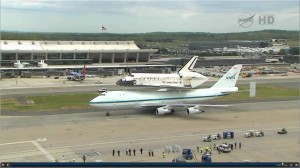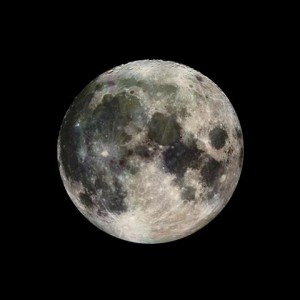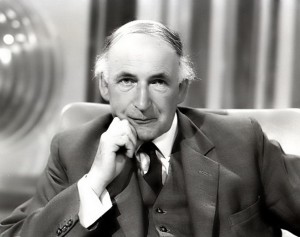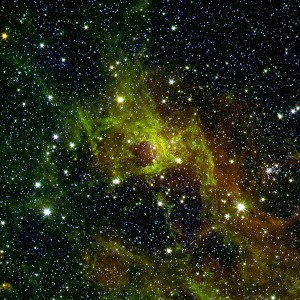
Drake Equation Plaque in the NRAO Green Bank Residence Hall Lounge. Photo courtesy NRAO/NSF/AUI.
If you were following the news out of the Kepler Conference last week, you might have heard the announcement that the SETI search using the Allen Telescope Array (ATA) is back in business. The ATA had been mothballed in April due to budget problems, but new funding from public donations and the U.S. Airforce Space Command will allow SETI to resume its work with a focus on exoplanets discovered by Kepler’s space telescope.
Attentive reader’s of SETI’s press release may have noticed the following tribute to Bob Rood and his work:
“Until recently many SETI searches focused on limited frequency ranges, including a small number of observations at the 8.67 GHz spin-flip transition of the 3He+ ion, proposed by the team of Bob Rood (University of Virginia) and Tom Bania (Boston University). In memory of Rood, who died November 2, the initial ATA search of Kepler targets this week will focus around the 8.67 GHz band, before moving on to examine the billions of channels available for observation at the ATA.”
At first glance, this seems like a nice gesture and an appropriate way to honor a colleague. However, even those having only a passing acquaintance with Bob probably suspect there’s a story behind the SETI tribute. There is, and it’s a good one—I’ll try to do it justice here.
First, to understand the intent of SETI’s proposal, you first need to know a little bit about the organization’s history. SETI got its start at NRAO Green Bank, following the work of astronomer Frank Drake, who conducted a series of observations of Tau Ceti and Epsilon Eridani with a radio telescope. Drake tuned the telescope to a frequency of atomic hydrogen, 1,420 MHz (or so—the exact frequency of the 21 cm hydrogen line is 1420.40575177 MHz), theorizing that if extraterrestrial intelligence was trying to communicate with us, they would do so by using the most abundant element in the universe as an “interstellar beacon.”
Drake’s early attempts to detect extraterrestrial intelligence, while not successful in the sense that he instantly made contact and changed the fate of the universe, were influential in that they served as the model for the future SETI. In 1961, he called together a group of like-minded individuals to present his research findings and future plans. As part of this meeting, he proposed what is now called “The Drake Equation” (N=R*fpneflfifcL), an estimate of how many—and what type of—extraterrestrial civilizations we could expect to find in the universe.
I mention the Drake Equation because it has served as an inspiration, in one way or another, to many astronomers involved with SETI (within and outside the formal organization). Take, for instance, an interesting bit of research proposed by Bob Rood and Tom Bania in 1992. Noting an adherence to Drake Equation’s required an almost willfully simplistic understanding of extraterrestrial intelligence, Rood and Bania proposed “A Novel Search for SETI Beacons” using Green Bank resources.[1] On one hand, the proposal is perfectly sensible: if we’re searching for a universal reference, easily recognized by us and any other intelligent civilization in the universe, why keep guessing at a frequency? Why not use a frame of reference presumably known to all—that of cosmic background radiation? Rood and Bania refer to this universal frame of reference as “the Frame of God (FOG),” leading to one of the best footnotes in the history of academic writing.[2]
As the proposal suggests, Rood and Bania were skeptical of SETI’s reliance on the frequency of the hydrogen line and “the water hole,” and so proposed 3He+ as the new “magic” beacon rest frequency. Although the suggestion is couched in humor (no civilization wants to annoy its radio astronomers!), later publications (and Bob’s license plate) indicate that underneath the joking, there was a serious agenda.

Just one of Bob's license plates
For instance, in “Search for Interstellar Beacons at the 3He+ Hyperfine Transition Frequency,” Bania and Rood posit multiple arguments for the privileging of 3He+ in future SETI efforts.[3] 3He+ has the second simplest hyperfine transition after the 21cm hydrogen line; any intelligent civilization studying interstellar hydrogen would also study 3He. Naturally occurring 3He+ is found only in interstellar plasmas; further, the 3He+ lines in those regions are weak. Any strong 3He+ signal detected away from an HII region/planetary nebula would almost certainly be artificial. And so on.
The point is: although the scientific argument was completely serious, Bob found a way to make it fun as well. I’m not the only one who thinks so. Read, for instance, the comments of Anonymous Referee A for the “A Novel Search for SETI Beacons” proposal:
“When I read the title of this proposal I shook my head sadly and thought that two more astronomers were reaching their dotage. However, as I read through the proposal I found myself grinning and nodding my head. I don’t like SETI searches from phtlosophical considerations, but this proposal is innovative enough to merit a try, if for no other reason then to reward the imagination and wittiness of the proposers. They won’t find ETI’s of course, (there’s a bigger chance of me winning the lottery or getting NSF funding …. ) but who knows what will turn up?
“…the innovative methods outlined in this proposal, the rest frame augment, the fact that the observations won’t interfere with normal observations, and also the fact that the two proposers haven’t set up a huge bureaucratic organization to accomplish their objective makes this proposal worth scheduling. Kudos to Rood & Bania.”
(Admittedly, Anonymous Referees B & C were less enthusiastic: “A good use for dead time.” “Low, low priority.” Can’t please everybody, I guess.)
I hope this somewhat verbose explanation of the SETI tribute captures at least the spirit, if not the fine nuances of the scientific intent, behind Bob’s work. Kudos to SETI for recognizing his contributions to the field even though he poked fun at their organization every now and then. I’m angry that Bob’s gone—I had a long list of things I wanted to tell him. I’m selfishly upset that I never got a chance to ask him about one of my own research problems. I’m sad for his friends and his colleagues, and especially for his family. But I have to admit, I’m really, really sad for myself.
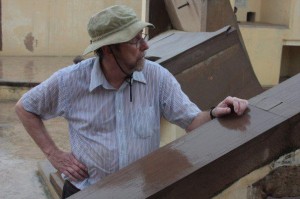
Bob Rood at the Jantar Mantar observatory, Varanasi, India, July 2009. Photo courtesy of the Snell-Rood family.
——————————-
[1] According to Tom Bania, the tone of the proposal is “all Bob’s. You will all recognize the prose. (I edited it into English, of course.).” (Personal correspondence with Claire Snell-Rood, 11/30/2011)
[2] Read the linked proposal, otherwise “*Bob Vance has checked the 140 foot control system and it appears that with a minor software patch we can observe in the FOG” probably won’t seem very funny.
[3] Third Decennial US-USSR Cotiference on SETI, ASP Conference Series, Vol. 47, 1993, G. Seth Shostak (ed.), pp. 357-65.


